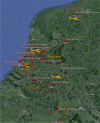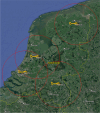A national multi centre pre-hospital ECPR stepped wedge study; design and rationale of the ON-SCENE study
- PMID: 38632661
- PMCID: PMC11022459
- DOI: 10.1186/s13049-024-01198-x
A national multi centre pre-hospital ECPR stepped wedge study; design and rationale of the ON-SCENE study
Abstract
Background: The likelihood of return of spontaneous circulation with conventional advanced life support is known to have an exponential decline and therefore neurological outcome after 20 min in patients with a cardiac arrest is poor. Initiation of venoarterial ExtraCorporeal Membrane Oxygenation (ECMO) during resuscitation might improve outcomes if used in time and in a selected patient category. However, previous studies have failed to significantly reduce the time from cardiac arrest to ECMO flow to less than 60 min. We hypothesize that the initiation of Extracorporeal Cardiopulmonary Resuscitation (ECPR) by a Helicopter Emergency Medical Services System (HEMS) will reduce the low flow time and improve outcomes in refractory Out of Hospital Cardiac Arrest (OHCA) patients.
Methods: The ON-SCENE study will use a non-randomised stepped wedge design to implement ECPR in patients with witnessed OHCA between the ages of 18-50 years old, with an initial presentation of shockable rhythm or pulseless electrical activity with a high suspicion of pulmonary embolism, lasting more than 20, but less than 45 min. Patients will be treated by the ambulance crew and HEMS with prehospital ECPR capabilities and will be compared with treatment by ambulance crew and HEMS without prehospital ECPR capabilities. The primary outcome measure will be survival at hospital discharge. The secondary outcome measure will be good neurological outcome defined as a cerebral performance categories scale score of 1 or 2 at 6 and 12 months.
Discussion: The ON-SCENE study focuses on initiating ECPR at the scene of OHCA using HEMS. The current in-hospital ECPR for OHCA obstacles encompassing low survival rates in refractory arrests, extended low-flow durations during transportation, and the critical time sensitivity of initiating ECPR, which could potentially be addressed through the implementation of the HEMS system. When successful, implementing on-scene ECPR could significantly enhance survival rates and minimize neurological impairment.
Trial registration: Clinicaltyrials.gov under NCT04620070, registration date 3 November 2020.
Keywords: Advanced cardiac life support; Cardiopulmonary resuscitation; Extracorporeal membrane oxygenation; Out-of-hospital cardiac arrest.
© 2024. The Author(s).
Conflict of interest statement
D. Dos Reis Miranda received speaking fee from Getinge Netherlands. The rest of the authors declare that they have no competing interests.
Figures



References
-
- Matsuyama T, Kitamura T, Kiyohara K, Nishiyama C, Nishiuchi T, Hayashi Y, et al. Impact of cardiopulmonary resuscitation duration on neurologically favourable outcome after out-of-hospital cardiac arrest: a population-based study in Japan. Resuscitation. 2017;113:1–7. doi: 10.1016/j.resuscitation.2017.01.005. - DOI - PubMed
-
- Matsuyama T, Ohta B, Kiyohara K, Kitamura T. Cardiopulmonary resuscitation duration and favorable neurological outcome after out-of-hospital cardiac arrest: a nationwide multicenter observational study in Japan (the JAAM-OHCA registry) Crit Care. 2022;26(1):120. doi: 10.1186/s13054-022-03994-2. - DOI - PMC - PubMed
-
- ELSO. ELSO registry data summary. 2022. Available from: https://www.elso.org/registry/internationalsummaryandreports/reports.aspx.
Publication types
MeSH terms
Associated data
LinkOut - more resources
Full Text Sources
Medical
Miscellaneous

